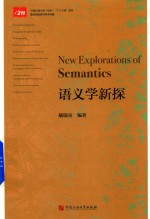
- 作 者:戴瑞亮编著
- 出 版 社:东营:石油大学出版社
- 出版年份:2016
- ISBN:9787563653645
- 标注页数:318 页
- PDF页数:334 页
请阅读订购服务说明与试读!
订购服务说明
1、本站所有的书默认都是PDF格式,该格式图书只能阅读和打印,不能再次编辑。
2、除分上下册或者多册的情况下,一般PDF页数一定要大于标注页数才建议下单购买。【本资源334 ≥318页】
图书下载及付费说明
1、所有的电子图书为PDF格式,支持电脑、手机、平板等各类电子设备阅读;可以任意拷贝文件到不同的阅读设备里进行阅读。
2、电子图书在提交订单后一般半小时内处理完成,最晚48小时内处理完成。(非工作日购买会延迟)
3、所有的电子图书都是原书直接扫描方式制作而成。
Chapter 1 Semantics in linguistics 1
1.1 Definition of semantics 1
1.2 Semantics and semiotics 1
1.3 Semantics and pragmatics 2
1.4 Some important assumptions 2
1.4.1 Reference and sense 3
1.4.2 Utterances,sentences and propositions 4
1.4.3 Sentence meaning and utterance meaning 6
1.4.4 Literal and non-literal meaning 7
1.4.5 Refer and denote 9
1.4.6 Referents and extensions 9
1.4.7 Conceptual meaning and associative meaning 9
1.5 Meanings of meaning 10
1.5.1 The referential theory:meaning as naming 10
1.5.2 Conceptualism:meaning as concept 11
1.5.3 Contextualism:meaning as context 13
1.5.4 Behaviorism:meaning as behavior 14
1.6 Summary 15
Chapter 2 Language,thought and reality 16
2.1 Language and thought 16
2.1.1 Language determines thought 16
2.1.2 Thought determines language 25
2.1.3 The language Of thought hypothesis 26
2.2 Thought and reality 27
2.3 Language and reality 28
2.4 Summary 29
Chapter 3 Word meaning 31
3.1 What is a word? 31
3.2 Lexical ambiguity and vagueness 33
3.3 Sense relations 36
3.3.1 Synonymy 36
3.3.2 Antonymy 37
3.3.3 Hyponymy 39
3.3.4 Homonymy 40
3.3.5 Polysemy 41
3.3.6 Meronymy 42
3.3.7 Member—collectiOn 43
3.3.8 Portion—mass 43
3.4 Summary 44
Chapter 4 Sentence relations and truth 45
4.1 Logic and truth 45
4.2 Necessary truth,a priori truth and analyticity 50
4.3 Entailment 53
4.4 Presupposition 56
4.4.1 Two approaches to presupposition 57
4.4.2 Presupposition failure 59
4.4.3 Presupposition triggers 60
4.4.4 Presuppositions and context 63
4.5 Summary 65
Chapter 5 Sentence semantics 1:situations 66
5.1 Situation types 66
5.2 Verbs and situation types 67
5.2.1 Stative verbs 68
5.2.2 Dynamic verbs 69
5.3 A system Of situation types 72
5.4 Modality and evidentiality 73
5.4.1 Modality 73
5.4.2 Interpretations of some modal verbs 78
5.4.3 Evidentiality 81
5.5 Summary 82
Chapter 6 Sentence semantics 2:thematic roles 83
6.1 Thematic roles 84
6.2 Identification of thematic roles 86
6.3 Grammatical relations and thematic roles 87
6.4 Problems with thematic roles 89
6.5 The motivation for identifying thematic roles 92
6.6 Voice 93
6.7 Summary 94
Chapter 7 Context and inference:a pragmatic study of meaning 1 96
7.1 Deixis 96
7.1.1 Place deixis 97
7.1.2 Person deixis 99
7.1.3 Time deixis 100
7.1.4 Discourse deixis 101
7.1.5 Social deixis 102
7.1.6 Grammaticalization of contextual information 102
7.1.7 Metaphorical relationship between space,time and discourse deixis 103
7.2 Reference and context 104
7.3 Knowledge as context 106
7.3.1 Situation as context 106
7.3.2 Discourse as context 107
7.3.3 Background knowledge as context 110
7.3.4 Giving background knowledge to computers 111
7.4 Information structure 113
7.5 Inference 117
7.6 Conversational implicature 125
7.6.1 Grice's Cooperative Principle 125
7.6.2 Post-Gricean developments 133
7.7 Summary 143
Chapter 8 Speech act theory:a pragmatic study Of meaning 2 145
8.1 Austin's Speech Act Theory 148
8.1.1 The performative-constative dichotomy 148
8.1.2 Felicity conditions 150
8.1.3 Collapse of the dichotomy 152
8.1.4 Atheory of illocutionary act 153
8.2 Searle's theory of speech acts 154
8.3 Indirect speech acts 158
8.4 Indirect speech acts and politeness 161
8.5 Summary 163
Chapter 9 Decomposition of meaning 164
9.1 Componential analysis 164
9.2 Katz's semantic theory 169
9.2.1 The Katzian dictionary 170
9.2.2 Projection rules 171
9.3 Components and conflation patterns 174
9.4 Conflation patterns Of motion verbs in English and Chinese 177
9.4.1 Conflation patterns of manner verbs in English and Chinese 177
9.4.2 Conflation patterns of path verbs in English and Chinese 183
9.5 Predication analysis 188
9.6 Summary 189
Chapter 10 Cognitive semantics 190
10.1 Metaphor and metonymy 193
10.1.1 Metaphor 193
10.1.2 Metonymy 205
10.1.3 Metaphor-metonymy interaction 212
10.2 Image schema 214
10.2.1 Containment schema 216
10.2.2 Path schema 219
10.2.3 Force schema 220
10.3 Polysemy 223
10.3.1 Prepositions 223
10.3.2 Modal verbs 227
10.4 Categorization and idealized cognitive models 230
10.4.1 Categorization 230
10.4.2 Idealized cognitive models 238
10.5 Iconicity 250
10.5.1 Iconicity of order 251
10.5.2 Iconicity of distance 259
10.5.3 Iconicity of quantity 265
10.5.4 Philosophical interpretation of iconicity 270
10.5.5 Iconicity and Other competing principles 272
10.6 Mental spaces 276
10.6.1 Connections between spaces 280
10.6.2 Referential opacity 283
10.6.3 Presupposition 287
10.7 Conceptual blending 288
10.7.1 The Origins of Blending Theory 290
10.7.2 Towards a theory of conceptual integration 291
10.7.3 The nature of blending 297
10.7.4 Contrasting Blending Theory with Conceptual Metaphor Theory 304
10.8 Grammaticalization 306
10.9 Summary 309
Bibliography 311
